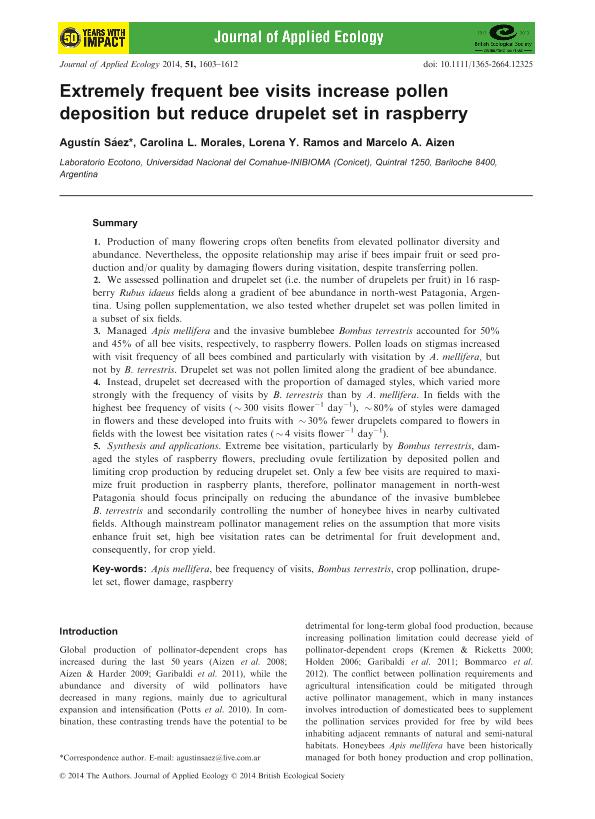Mostrar el registro sencillo del ítem
dc.contributor.author
Sáez, Agustín

dc.contributor.author
Morales, Carolina Laura

dc.contributor.author
Ramos, Lorena Yésica

dc.contributor.author
Aizen, Marcelo Adrian

dc.date.available
2017-01-27T21:14:42Z
dc.date.issued
2014-12
dc.identifier.citation
Sáez, Agustín; Morales, Carolina Laura; Ramos, Lorena Yésica; Aizen, Marcelo Adrian; Extremely frequent bee visits increase pollen deposition but reduce drupelet set in raspberry; Wiley; Journal Of Applied Ecology; 51; 6; 12-2014; 1603-1612
dc.identifier.uri
http://hdl.handle.net/11336/12141
dc.description.abstract
1. Production of many flowering crops often benefits from elevated pollinator diversity and abundance. Nevertheless, the opposite relationship may arise if bees impair fruit or seed production and/or quality by damaging flowers during visitation, despite transferring pollen.
2. We assessed pollination and drupelet set (i.e. the number of drupelets per fruit) in 16 raspberry Rubus idaeus fields along a gradient of bee abundance in north-west Patagonia, Argentina. Using pollen supplementation, we also tested whether drupelet set was pollen limited in a subset of six fields.
3. Managed Apis mellifera and the invasive bumblebee Bombus terrestris accounted for 50% and 45% of all bee visits, respectively, to raspberry flowers. Pollen loads on stigmas increased with visit frequency of all bees combined and particularly with visitation by A. mellifera, but not by B. terrestris. Drupelet set was not pollen limited along the gradient of bee abundance.
4. Instead, drupelet set decreased with the proportion of damaged styles, which varied more strongly with the frequency of visits by B. terrestris than by A. mellifera. In fields with the highest bee frequency of visits ( 300 visits flower1 day1 ), 80% of styles were damaged in flowers and these developed into fruits with 30% fewer drupelets compared to flowers in fields with the lowest bee visitation rates ( 4 visits flower1 day1 ).
5. Synthesis and applications. Extreme bee visitation, particularly by Bombus terrestris, damaged the styles of raspberry flowers, precluding ovule fertilization by deposited pollen and limiting crop production by reducing drupelet set. Only a few bee visits are required to maximize fruit production in raspberry plants, therefore, pollinator management in north-west Patagonia should focus principally on reducing the abundance of the invasive bumblebee B. terrestris and secondarily controlling the number of honeybee hives in nearby cultivated fields. Although mainstream pollinator management relies on the assumption that more visits enhance fruit set, high bee visitation rates can be detrimental for fruit development and, consequently, for crop yield.
dc.format
application/pdf
dc.language.iso
eng
dc.publisher
Wiley

dc.rights
info:eu-repo/semantics/openAccess
dc.rights.uri
https://creativecommons.org/licenses/by-nc-sa/2.5/ar/
dc.subject
Apis Mellifera
dc.subject
Bee Frequency of Visits
dc.subject
Bombus Terrestris
dc.subject
Crop Pollination
dc.subject.classification
Agricultura

dc.subject.classification
Agricultura, Silvicultura y Pesca

dc.subject.classification
CIENCIAS AGRÍCOLAS

dc.title
Extremely frequent bee visits increase pollen deposition but reduce drupelet set in raspberry
dc.type
info:eu-repo/semantics/article
dc.type
info:ar-repo/semantics/artículo
dc.type
info:eu-repo/semantics/publishedVersion
dc.date.updated
2016-12-12T14:24:07Z
dc.identifier.eissn
1365-2664
dc.journal.volume
51
dc.journal.number
6
dc.journal.pagination
1603-1612
dc.journal.pais
Estados Unidos

dc.journal.ciudad
Hoboken
dc.description.fil
Fil: Sáez, Agustín. Consejo Nacional de Investigaciones Científicas y Técnicas. Centro Científico Tecnológico Patagonia Norte. Instituto de Investigación En Biodiversidad y Medioambiente; Argentina. Universidad Nacional del Comahue. Centro Regional Universitario Bariloche. Laboratorio de Ecotono; Argentina
dc.description.fil
Fil: Morales, Carolina Laura. Consejo Nacional de Investigaciones Científicas y Técnicas. Centro Científico Tecnológico Patagonia Norte. Instituto de Investigación En Biodiversidad y Medioambiente; Argentina. Universidad Nacional del Comahue. Centro Regional Universitario Bariloche. Laboratorio de Ecotono; Argentina
dc.description.fil
Fil: Ramos, Lorena Yésica. Consejo Nacional de Investigaciones Científicas y Técnicas. Centro Científico Tecnológico Patagonia Norte. Instituto de Investigación En Biodiversidad y Medioambiente; Argentina. Universidad Nacional del Comahue. Centro Regional Universitario Bariloche. Laboratorio de Ecotono; Argentina
dc.description.fil
Fil: Aizen, Marcelo Adrian. Consejo Nacional de Investigaciones Científicas y Técnicas. Centro Científico Tecnológico Patagonia Norte. Instituto de Investigación En Biodiversidad y Medioambiente; Argentina. Universidad Nacional del Comahue. Centro Regional Universitario Bariloche. Laboratorio de Ecotono; Argentina
dc.journal.title
Journal Of Applied Ecology

dc.relation.alternativeid
info:eu-repo/semantics/altIdentifier/doi/http://dx.doi.org/10.1111/1365-2664.12325
dc.relation.alternativeid
info:eu-repo/semantics/altIdentifier/url/http://onlinelibrary.wiley.com/doi/10.1111/1365-2664.12325/abstract
Archivos asociados
